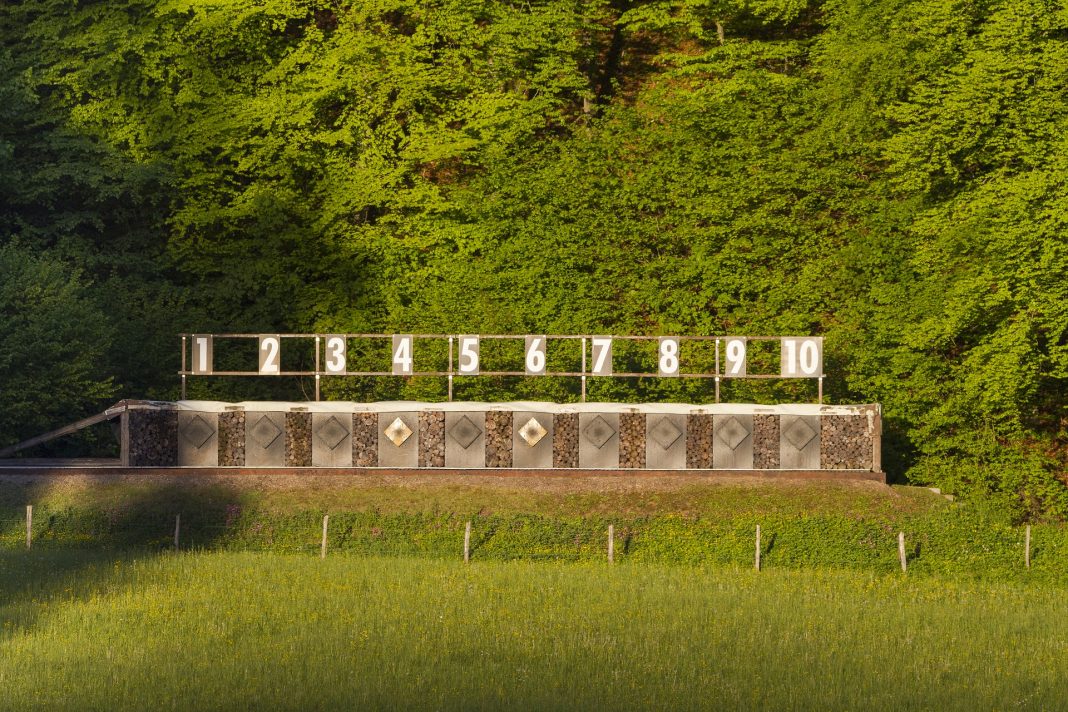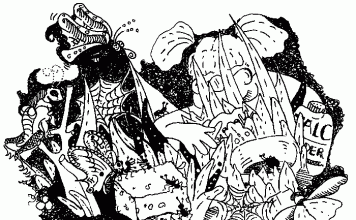 |
|
| Issue #100 • July/August, 2006 |
In the long love affair between America and the rifle, there has never been an interlude quite as intensive as the epoch of the .30-06. This cartridge celebrated its 100th anniversary in 2006. It is still going strong, a favorite of hunters and shooters. It was the primary military small-arm caliber of the United States Army for more that half a century. The Speer Reloading Manual noted many years ago, “No other smokeless powder rifle cartridge has achieved the popularity and wide use of the .30-06. It has been used with great success by big game hunters and target shooters for almost three quarters of a century. The U.S. and many other nations have used it as a standard rifle and machine gun cartridge.”

Designed with a view to replacing the Krag rifle and its .30-40 round after the Spanish-American War, this cartridge actually began as the .30-03, with a 220-grain bullet loaded to a velocity of 2300 feet per second. New developments in European small arms and ballistics, however, quickly convinced the U.S. military’s ordnance experts to go to a lighter, faster bullet, loaded into a slightly shorter cartridge casing. The new round was accordingly tweaked, and the result was the .30 caliber U.S. cartridge of 1906, hence the designation of “.30-06.” It had been designed for the Springfield bolt-action military rifle of 1903 (thus, the “30-03” designation for its original cartridge), and the new load was officially known thereafter as the .30-06 Springfield.
This was the cartridge that America brought to World War I, the Springfield rifle augmented with the Enfield 1917 model. Both were rugged bolt-action guns that could quickly be reloaded through the top of their mechanism with five-round “stripper clips.” The same cartridge would be used for the magnificent BAR, the Browning Automatic Rifle, which hit the field at the very end of WWI and did noble service for the United States in the Second World War. Alongside the BAR in the Pacific and European Theaters alike was the fabulous M1 Garand, an eight-shot semiautomatic rifle, which gave American infantry a deadly edge against the slower bolt-action Mausers of the Germans and Arisakas of the Japanese. The .30-06 would march through Korea, too, as the standard U.S. cartridge, before giving way in the late 1950s to the M14 rifle and its 7.62mm NATO round, which in essence was simply a shortened .30-06. The 7.62mm NATO military round is known in sporting circles as the .308 Winchester.
 The gun that started it all: The 1903 Springfield service rifle, caliber .30-06. |
 A 1903 Springfield A3 sporter, still at work after all these decades. Caliber, of course, is .30-06. |
 Author’s favorite .30-06 these days is this Ruger Model 77. It will hold every shot in less than an inch at 100 yards. |
The .30-06 round was in service as late as the Vietnam war. Carlos Hathcock, the famously deadly Marine sniper, used .30-06 there before being forced to switch to a .308.
Though the M1 Garand and the BAR are now relegated to the museums as far as the U.S. military is concerned, back on the home front the .30-06 remains the most widely used sporting cartridge in the country. For as long as this writer has been alive, the .30-06 has been the most popular center-fire rifle cartridge in this country.
There are good reasons why, and as the cartridge celebrates its centennial in 2006, it is worth reviewing those reasons.
All manner of exotic, high-velocity, fat-bodied cartridges crowd the hunting fields and the outdoor magazines today. But talk to conservation officers and ask them what round is used to bring down the most deer in the jurisdictions where they work. The answer you’ll hear will very likely be, “thirty-ought-six.” Try to get a box of .338 WSM (Winchester Super Magnum) at the little rural general store with the gasoline pump out front. They’ll try not to laugh in your face. But if they sell ammunition at all, you can be sure they’ll have some .30-06 in stock.
In its century-long march across the pages of American history, the ought-six has made a slew of friends. Some of them were famous. The .30-06 was probably the choice of more Presidents than any other rifle in history. Theodore Roosevelt took one to Africa, a beautiful sporting version of the Springfield. Harry Truman was issued a .30-06, like every other doughboy in the trenches of World War I. (He also carried a 1917 model .45 revolver in that conflict—no new-fangled automatic for the practical Harry!) There are pictures of Franklin Delano Roosevelt as a young man, wearing a leather shooting coat and preparing to shoot a rifle match with a Springfield .30-06. Jack Kennedy and George Bush alike would have qualified with the Springfield and maybe the Garand during the basic training that began their World War II service. Lyndon Johnson was as likely to have a .30-06 as anything else in the front seat with him as he drove guests across the plains of his LBJ Ranch, looking for deer to shoot from the front seat of his open-top Lincoln Continental.
America’s gun experts all took the ought-six to their bosoms. The late, great Jack O’Connor was most famous for his advocacy of the .270 Winchester cartridge and the 7mm Mauser round, but some of his favorite hunting rifles were chambered for the .30-06. Elmer Keith considered the .30-06 altogether too light for elk or moose, but allowed it was suitable for smaller critters, and shot many a match with the cartridge. It was also one of the favored cartridges of William B. Ruger, perhaps the most acclaimed sporting arms designer of recent times.
Henry Stebbins was one of the top all-around gun experts of the mid-20th Century. He had much to say about the .30-06 cartridge in his classic book Rifles: A Modern Encyclopedia. Stebbins wrote, “Up to the limit of its killing power, which is considerable, the .30-06 is still our best all-round cartridge. Few smaller sizes handle round bullets so accurately, and at the other extreme, 250 grains is a respectable weight-in a long bullet like a .30—for any American big game.”
Versatility is one of the key reasons for the .30-06’s popularity in rural America. A well-off sportsman may have a battery of 20 different rifles for hunting 20 different combinations of quarry and terrain…the homesteader or full-time outdoorsman may be limited by finances, logistics, or “keep things simple” philosophy to one rifle for all purposes. Those who reload their ammunition have a bullet weight range of 100 grains (light recoil loads for informal target shooting or “plinking”) through those big 250-grain custom loads that Stebbins was talking about. In factory-produced ammunition, the range is from 110-grain bullets for varmint hunting to heavily constructed 220-grain projectiles suitable for bear, moose, and much of Africa’s large plains game.
When I hunted in the Republic of South Africa and in Southwest Africa (now Namibia), I noticed that many of the indigenous big-game hunters chose the .30-06 as their “light” rifle for plains animals such as kudu, gemsbok, and other giant antelope. While some considered the cartridge a little light for critters that big, the Afrikaaners had learned over generations that with 220-grain bullets with round, soft, noses, the .30-06 would reliably shoot deep enough into big soft-skinned animals to put them down. Many of them felt it was suitable for lion as well.
A ballistic patriarchy
The .30-06, in 100 years, became the father of many other cartridges. “Neck it down” (that is, narrow the forward part of its taper to hold a smaller, lighter projectile that can go faster at similar internal pressures) and you have the almost equally timeless .270 Winchester. Neck it down further, to a mere quarter inch of bullet diameter, and you have the .25-06, a favorite for small American pronghorn antelope. Widen its case mouth to hold a fatter bullet, and you have the .35 Whelen, a big game cartridge beloved by the cognoscenti for decades.
Shorten the .30-06, and you have the .308 Winchester/7.62mm NATO, today the odds-on choice of military snipers and the precision riflemen on police SWAT teams. Take that cartridge in turn: neck it down, and you have the popular .243 Winchester, or neck it up to create the promising if unpopular .358 Winchester.
The above are not the only ballistic developments that can trace their lineage to the .30-06 cartridge.
As Frank C. Barnes noted in his authoritative text Cartridges of the World, the key to both the popularity and the versatility of this cartridge is the user’s ability to select the particular loading of the cartridge that is right for the job at hand. Said Barnes, “The .30-06 is undoubtedly the most flexible, useful, all-round big-game cartridge available to the American hunter. For many years it has been the standard by which all other big-game cartridges have been measured. To say that a cartridge is in the .30-06 class means it is suitable for any game in North America. The secret of success when using this cartridge is to be sure and select the right bullet for the game and hunting conditions at hand. The lighter bullets…should only be used for varmint hunting. While these bullets can be driven at impressive velocities, starting out at over 3000 fps (feet per second), they are made to expand rapidly on small animals and will not penetrate properly on large game. For deer, antelope, goat, sheep, black or brown bear, under most hunting conditions, the 150 or 165-grain bullet is proper. For heavier game, such as elk, moose, or the big brown bear, the 180, 200 or 220-grain bullet is the best choice….As a matter of fact, the .30-06 will give a good account on all but the heaviest or most dangerous African or Asiatic species under average hunting conditions. The 220-grain bullet is generally recommended for African game, although the 180-grain also has a good reputation there. With the proper bullet, this cartridge can be adapted to any game or hunting situation in North or South America, whether in the mountains, plains, woods or jungle. Few other cartridges can claim equal versatility.”
Most ammunition manufacturers gear their 180-grain bullets for heavier animals, putting stronger copper jackets on them so the bullets expand more slowly and therefore penetrate deeper.
Over the years, I came to the conclusion that the thinner jackets on the faster 150-grain bullets made them ideally suitable for smaller and medium-size whitetail deer. The 165-grain bullet is, like the 150-grain, particularly accurate in most .30-06 rifles, and the 165-grain is the bullet weight I’d choose for all-around use in a .30-06.
The .30-06 has become all the more versatile in the last few years with two new trends. One is Hornady Ammunition’s Light Magnum ammo series, which offers .30-06 loads at higher than usual velocities for the variety of bullet weights available. Another is the proliferation across the brand lines of premium ammunition that uses high-tech bullets like the Nosler Ballistic Tip, the Winchester Ballistic Silvertip, and more. Sport shooters once had to “roll their own” to get that level of specialized performance. Now, in .30-06 among other calibers, it’s available over-the-counter.
Other side of versatility
When a backwoods person hefts a .30-06, one side of its versatility is the cartridge it fires. The other is the kind of rifle that fires it. Over the years, every type of popular rifle mechanism has been adapted to fire the .30-06 cartridge.
Semiautomatic rifles. At the beginning of WWI, the timeless M1 designed by John Garand and the unique Johnson rifle purchased in small quantities by the US Marine Corps, proved that this high-powered cartridge could work in a self-loading mechanism. When GIs came home en masse after the victory, they had an appreciation for rifles that could fire as fast as they could pull the trigger, and a demand arose for sporting .30-06 autoloaders.
Remington was the first to answer that demand, and their version has been the most popular forever after. Introduced in 1955, the five-shot Model 740 was an instant success. It was soon upgraded into the Model 742 and the Model Four, and has remained hugely popular—particularly where deer are hunted in heavy timber at close range—ever since.
|
Browning followed with another gun called the BAR, and while this model also stood for “Browning Automatic Rifle,” it was a sleek five-shot sporting arm of exquisite craftsmanship and high natural accuracy potential, and a far cry from the splendid battle machine that fought for America from the end of WWI through Vietnam.
The M1 Garand of “the best generation” is now produced in a civilian version by Springfield Armory in Geneseo, Illinois. Military surplus Garands can be had by law-abiding American citizens through the CMP (Civilian Marksmanship Program) headquartered at Camp Perry near Port Clinton, Ohio. The .30-06 that kept the Free World free lives on.
Slide-action rifles. Curiously, while Americans created and took to their collective heart the slide-action shotgun, the same design of rifle has never been hugely popular. Again, it was Remington who made it possible, with their Model 760 pump gun introduced at mid-20th Century. In varied models, including the designations 76 and 7600, the Remington pump was the favorite of the famous Vermont deer hunting family, the Benoits, and at one time was issued by the FBI because of its commonality of handling with the slide-action Remington 870 police shotgun. .30-06 has always been one of the most popular calibers for the Remington pump rifle, perhaps the single most popular.
Lever-action rifles. Winchester produced their distinctive Model 1895 lever-action rifle in caliber .30-06, though there were gun experts then and now who felt that the design was too fragile for such a high-pressure cartridge. They may have been right, because the concept never caught on.
Single-shot rifles. Obsolete by every practical and logical standard, the single-shot hunting rifle survives today because of moral standards and esthetic standards. The esthetic standard: just look at them! They are beautifully balanced, by the test of the eye and the test of the hands alike. The moral standard: Some hunters think it best to handicap themselves by giving themselves only one shot at the quarry.
Many fine single-shot hunting rifles are produced today, virtually all available in caliber .30-06. The most popular is the Ruger.
Bolt-action rifles. Here we find the natural home, the ancestral home, the once and future home of the .30-06 caliber rifle. The Springfield Model 1903 was bolt action, of course, and so was the Enfield of 1917. .30-06 was the most popular caliber for Winchester’s defining bolt-action sporting rifle, the Model 54, and in 1936 when Winchester introduced their classic Model 70, it became far and away the best selling caliber for that model. (Ironically, this same year that celebrates the centennial of the .30-06 cartridge would have been the 70th anniversary of the Model 70, but the Winchester plant in Connecticut closed its historic doors in March of 2006.)
The Model 70 was known as “the rifleman’s rifle.” It was the choice of master shooters, rifle champions, and great hunters from the aforementioned Jack O’Connor to the also previously mentioned Carlos Hathcock, who used a Model 70 .30-06 to set the first stage of his deadly record as a Marine sniper in Vietnam before being issued a Remington bolt-action in .308.
That Remington was based on a sporting rifle known stateside as the Model 700, perhaps the single best-selling .30-06 today. Exquisitely accurate, deliciously smooth, and with a trigger pull that any trained marksman can appreciate, the Remington 700 is one of our classic hunting rifles in any caliber, and definitely one of the classic .30-06s.
|
Ruger’s Model 77 series are exquisite bolt-action sporting rifles. Accurate. Smooth. Traditional in style. And eminently shootable.
The Savage Model 110 and its descendants are high-value guns, historically delivering low bid price with exquisite accuracy. The Savage was also the first mass-produced bolt-action rifle to be manufactured in a left-handed version.
The list goes on. BSA in England, Musgrave of South Africa, Steyr of Austria, and countless more, as well as virtually every custom and semi-custom rifle maker in the U.S., have produced fine bolt-action .30-06 rifles.
The future of the .30-06
Like Shakespeare’s Julius Caesar, the .30-06 once “bestrode (its) narrow world like a Colossus.” Today, there are many more cartridges available with higher velocity, heavier bullets, and flatter trajectories than hunters had access to during the ought-six’s heyday. For a good half-century, the .30-06 absolutely ruled the National High Power Rifle Championships of the United States. Then the .308 Winchester took over in the winners’ circle, and today, custom-made rifles in the pipsqueak .223 caliber are the ones that win at the Nationals. You only see the .30-06 now in the specialty matches for “period guns,” and special events for M1 Garands.
The military’s switch almost half a century ago to the .308 was predicted at the time to sound the death knell for the .30-06. Those bells have remained silent. While the .308 has become hugely popular, the .30-06 has not declined that much by comparison. Its longer cartridge casing allows a wider range of bullet weight and velocity combinations. That range is 110-grain to 220-grain in .30-06 factory ammunition, but only 125-grain to 200-grain in .308 factory ammo.
When I was young, cheap military surplus .30-06 practice ammo was available in abundance. When a gun club I belonged to offered members up to a thousand rounds of GI ought-six ammo for a penny a cartridge, I bought the limit and then went out and bought a .30-06 to shoot it in. I still own the rifle, a Steyr Professional that would reliably put three shots into three quarters of an inch at 100 yards all day, if I held its Burris telescopic sight sufficiently steady. That ammo is long gone, but I still have the rifle. Back in the early ’90s—shooting match-grade Federal brand—that Steyr put me into the Top Ten of the Buckmasters international hunting rifle competition. It’s in the will for the kids, and not for sale…one of literally millions of fine .30-06 rifles that have performed so well when the chips were down that they earned their way into their owners’ hearts and became family heirlooms.
That cheap ammo is no longer a reason to choose a .30-06 over, say, a .270; the ought-six surplus ammunition is a thing of the past, and modern generic low-price ammo is no cheaper for .30-06 than for other calibers. Still, if you are going to have only one rifle, the .30-06 makes an excellent case for itself.
I’m right-handed, but I like the idea of having a left-handed rifle accessible, both to loan to southpaw friends and in case I sustain an injury that forces me to switch sides. My lefty bolt gun is a Savage Model 110, and because it would indeed be my only rifle if I was in that situation, I made sure to order it in caliber .30-06.
When I got divorced and moved from city to countryside, I had to leave most of my gun collection in storage to retrieve later, and took with me only the firearms I was most likely to need. The only bolt-action sporting rifle to make the cut was a pet Ruger 77 with 3-to-9X variable power telescopic sight. Its caliber? .30-06, of course.
The .30-06 rifle is an American icon. It earned its longevity through its ability to accomplish hard work and deliver practical performance on demand. Its 100th birthday is a fitting thing to celebrate in tandem with the 100th issue of Backwoods Home Magazine.



















Nice piece here, Mas.
My earliest hinting gun was a BSA Sporter in .30/06. I was 17 at the time, visiting cousins in Port Orchard Washington. Cousin took me downtown to Pete’s Gun Store (where we had already spent much time) and I paid I think it was about $75 to buy this. Years later I sold it to a good phriend. I have since acquired a number o other good quality huning long guns in .30/06 ad other chamberings. One othose being the excellent owning you mentioned above.